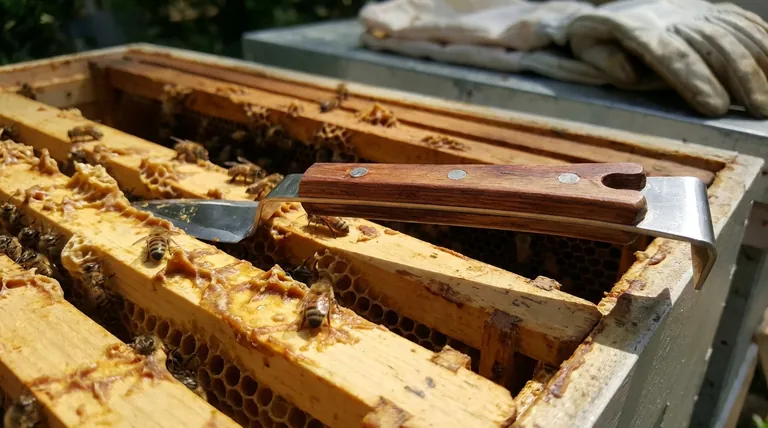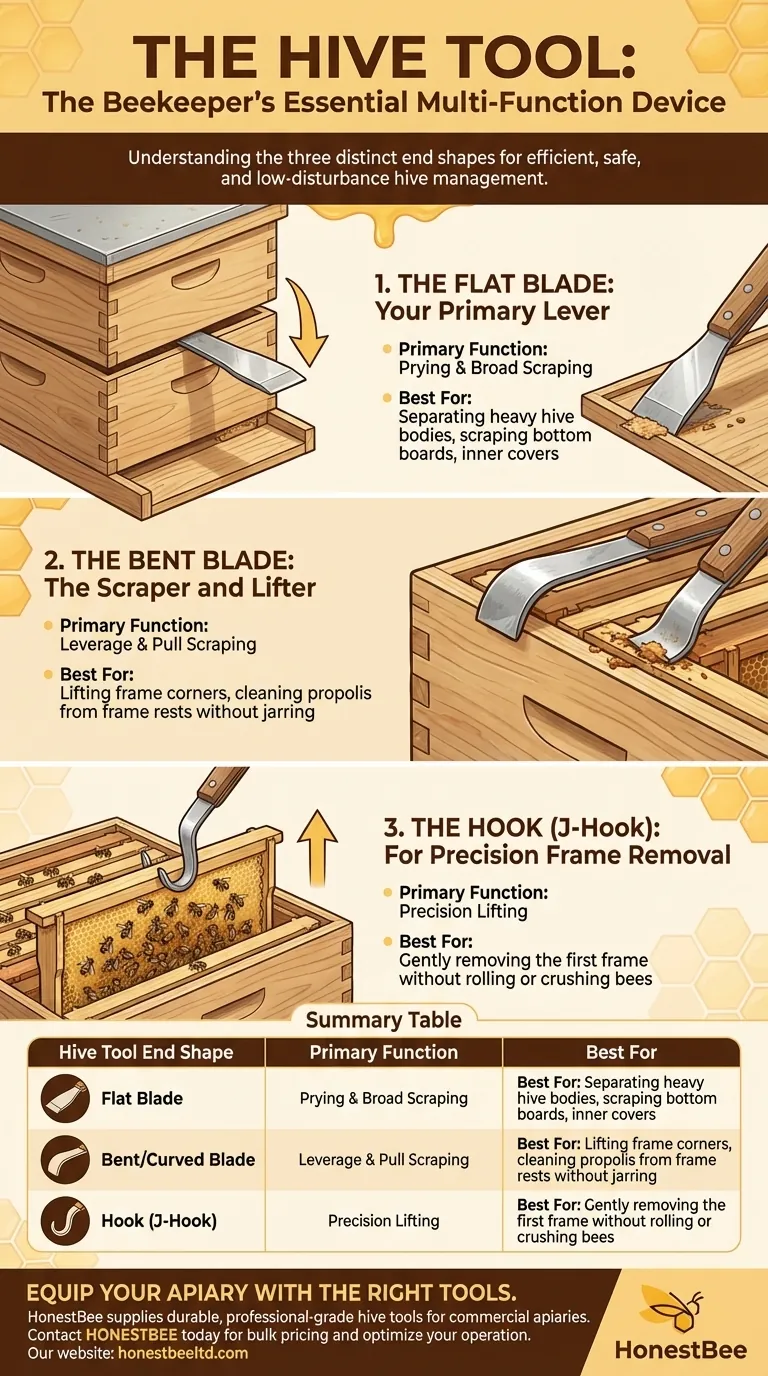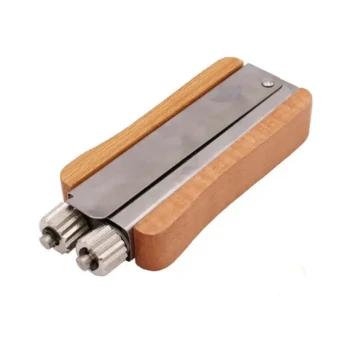At its core, a hive tool is the beekeeper's most essential extension of their own hands. It is a simple, multi-function device designed to perform dozens of tasks, from heavy prying to delicate scraping. The functionality of any hive tool is defined by its three primary end shapes: a straight, flat blade for prying; a bent or curved blade for leverage and scraping; and a hook for the precise lifting of frames.
A hive tool is far more than a simple pry bar. Understanding how each of its distinct shapes provides a specific mechanical advantage is the key to managing your hives efficiently, safely, and with minimal disturbance to the colony.

Deconstructing the Hive Tool: Shape and Function
The genius of the hive tool lies in its purpose-built ends. Bees use a sticky, resinous substance called propolis to seal every crack and seam in their hive, gluing components together. Each shape on a hive tool is designed to overcome this seal in a specific way.
The Flat Blade: Your Primary Lever
The flat, straight blade end, which often has a beveled edge, is your tool for applying broad, powerful force. Its primary purpose is to break the propolis seal between heavy hive bodies (supers).
By wedging this end between two boxes and twisting, you can separate them with significant leverage. It is also excellent for scraping large, flat surfaces like bottom boards or inner covers to remove burr comb and debris.
The Bent Blade: The Scraper and Lifter
The bent or curved end acts as a more controlled lever. This shape is expertly designed for prying up the corners of frames that are glued tightly to the hive body.
The bend allows you to rest part of the tool on the edge of the hive box, giving you the mechanical advantage to lift the frame end up without jarring the entire hive. It is also an excellent "pull scraper" for cleaning propolis from the recessed frame rests inside the hive body.
The Hook: For Precision Frame Removal
Often found on "J-hook" style tools, the hook is a specialized feature for the most delicate part of a hive inspection: removing the first frame.
The hook is designed to dip into the hive, snag the top bar of a frame, and lever it upwards and outwards. This allows you to lift a single frame vertically without rolling or crushing bees, which is a common risk when using other methods.
The Hive Tool as a Universal Problem-Solver
While the three ends define its core functions, a hive tool's robust construction makes it the beekeeper's go-to problem-solver. Its versatility falls into several key areas of hive management.
Maintaining Hive Integrity
A hive is a collection of precisely spaced wooden boxes, and a hive tool is essential for managing them. You will use it constantly to pry apart hive bodies, loosen a propolis-sealed telescoping cover, or separate an inner cover from the top super.
Ensuring Hive Hygiene
A clean hive is a healthy hive. The sharp edges of a hive tool are perfect for scraping away unwanted burr comb (wax built in undesirable places) and excess propolis from frames and boxes. This cleaning prevents pests from finding hiding places and ensures components fit together properly.
Gentle Frame Manipulation
Perhaps the most critical task is inspecting frames. A hive tool is used to gently loosen and lift frames, push frames together to restore proper bee space, and scrape excess wax or crystalized honey from a frame's surface during an inspection.
Understanding the Trade-offs and Variations
Not all hive tools are created equal, and most models are a combination of just two of the three primary end shapes. Choosing the right one depends on your needs and preferences.
Standard vs. J-Hook Tools
The most common hive tool, often called a "standard" or "crowbar" type, combines a flat blade on one end and a bent blade on the other. It is an excellent all-around tool for prying, scraping, and general-purpose work.
A J-hook tool combines a flat blade with a hooked end. This tool excels at gentle frame removal but gives up the bent end's utility as a pull scraper. Many beekeepers own both types for this reason.
The Importance of Length and Leverage
Hive tools range from small 6-inch pocket models to large 15-inch versions. A shorter tool is nimble and excellent for delicate, in-hive work. However, a longer tool provides significantly more leverage, making the job of separating heavy, propolis-sealed deep boxes much easier.
Making the Right Choice for Your Goal
Selecting a hive tool is a personal choice, but your goals can guide you to the best starting point.
- If your primary focus is versatility: Start with a standard 9- to 10-inch tool that combines a flat blade and a bent end, as it is the most capable all-around option.
- If your primary focus is gentle frame removal: Select a J-hook style tool for its unmatched ability to precisely lift the first frame with minimal disturbance.
- If your primary focus is managing many hives: Consider adding a longer (14+ inch) tool to your kit specifically for its superior leverage when separating stubborn boxes.
Ultimately, the right hive tool is one that feels balanced in your hand and allows you to work confidently and calmly within the hive.
Summary Table:
| Hive Tool End Shape | Primary Function | Best For |
|---|---|---|
| Flat Blade | Prying & Broad Scraping | Separating heavy hive bodies, scraping bottom boards. |
| Bent/Curved Blade | Leverage & Pull Scraping | Lifting frame corners, cleaning frame rests. |
| Hook (J-Hook) | Precision Lifting | Gently removing the first frame without crushing bees. |
Equip your apiary with the right tools for the job.
HONESTBEE supplies durable, professional-grade hive tools and beekeeping equipment to commercial apiaries and distributors. We understand that the right tool isn't a luxury—it's essential for efficient hive management and the health of your colonies.
Let us help you optimize your operation with our wholesale-focused selection. Contact HONESTBEE today to discuss your equipment needs and bulk pricing.
Visual Guide

Related Products
- HONESTBEE Premium Italian Style Hive Tool with Hardwood Handle
- HONESTBEE Professional Long Handled Hive Tool with Precision Cutting Blade
- HONESTBEE Advanced Ergonomic Stainless Steel Hive Tool for Beekeeping
- HONESTBEE Professional Multi-Functional Hive Tool with Ergonomic Wood Handle
- Professional Dual-End Stainless Steel Hive Tool for Beekeeping
People Also Ask
- Is it advisable to manage a large number of hives alone? The Risks of Solo Beekeeping at Scale
- How should beekeepers handle bees when using a hive tool? Master Calm, Deliberate Techniques
- What are some common uses of a hive tool? Essential Multi-Purpose Tool for Every Beekeeper
- What is the hive tool used for? The Essential Multi-Tool for Every Beekeeper
- What is required for regular inspections in both Flow Hives and Langstroth hives? Essential Beekeeping Tasks Explained



















